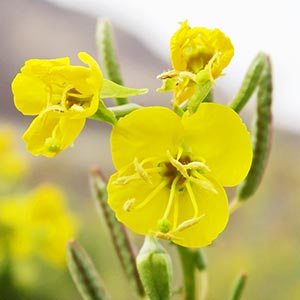Chylismia heterochroma
Chylismia claviformis
Shockley's evening-primrose
brown-eyed primrose, browneyes, clavate fruit primrose
several, 10–100 cm.
branched mostly from base, 3–70 cm.
primarily in poorly defined basal rosette, cauline greatly reduced when present;
petiole 0.4–8 cm;
blade unlobed, ovate to cordate, 2–11.5 × 1.4–5 cm, margins sinuate-dentate, brown oil cells prominently lining veins abaxially.
primarily in basal rosette, cauline reduced or absent, 1.5–20 × 0.3–3.5 cm;
petiole 0.7–12 cm;
blade usually pinnately lobed, sometimes lateral lobes poorly developed or absent, terminal lobe usually narrowly ovate to lanceolate, sometimes cordate or subcordate, 0.8–9 × 0.2–4.5 cm, margins dentate, sinuate-dentate, or serrate, brown oil cells conspicuously lining veins abaxially.
erect, elongating in anthesis.
nodding, elongating after anthesis.
opening at sunrise;
buds without free tips;
floral tube 2–5 mm, villous inside;
sepals 1.5–3.5 mm;
petals lavender, paler and often with flecks toward base, often yellow at very base, fading darker lavender, 2–6 mm;
stamens unequal, filaments of antisepalous ones 1.8–3 mm, of antipetalous ones 1–2.5 mm, anthers 0.6–1 mm, glabrous or sparsely ciliate;
style 4–7 mm, stigma surrounded by anthers at anthesis.
opening at sunset or sunrise;
buds with or without subapical or apical free tips;
floral tube 2–6.5 mm, villous inside proximally;
sepals 2–8 mm;
petals pale to bright yellow or white, sometimes red- or purple-dotted near base, fading purple, sometimes red or orange, or not changing color, 1.5–8 mm;
stamens subequal, filaments 1.5–5.5 mm, anthers 1.5–6 mm, ciliate;
style 5–16 mm, stigma exserted beyond anthers at anthesis.
erect, clavate, 7–13 mm;
pedicel 2–5 mm.
ascending to spreading, clavate, 8–40 mm;
pedicel 4–40 mm.
1–1.2 mm.
0.6–1.5 mm.
= 14.
Chylismia heterochroma
Chylismia claviformis
Chylismia heterochroma is known from Churchill and Lander counties, Nevada, south to Lincoln and southern Nye counties, Nevada, to adjacent California (Mono Lake, Mono County, and central Inyo counties). P. H. Raven (1962, 1969) determined this species to be self-compatible and autogamous.
(Discussion copyrighted by Flora of North America; reprinted with permission.)
Subspecies 11 (10 in the flora).
P. H. Raven (1962) subdivided this species into 12 subspecies and, subsequently (1969), he combined two of them. The latter approach is used here. Only subsp. wigginsii P. H. Raven does not occur in the United States; its narrow range is restricted to northern Baja California. Raven (1962, 1969) determined this species to be self-incompatible.
Chylismia claviformis is the most complex and, along with C. scapoidea, the most widely distributed species of the genus. The central part of its geographical range is occupied by five closely related white-petaled subspecies (aurantiaca, claviformis, funerea, integrior, and peeblesii) that are very similar morphologically. South of this area four additional subspecies occur, all yellow-petaled (peirsonii, rubescens, wigginsii, and yumae). These four subspecies have sepals and petal color similar to those of C. brevipes, and P. H. Raven (1962, 1969) thought it likely that they were derived following hybridization between that species and one of the white-petaled populations of C. claviformis. North of the range of the white-petaled subspecies are found two additional yellow-petaled subspecies (cruciformis and lancifolia). Most populations of subsp. cruciformis consist of plants in which the flowers open in the early morning; in all other subspecies the flowers open in the late afternoon (Raven 1962, 1969). The following key will separate them, but there are many intergrades among the subspecies so that not all specimens will be easily identified.
(Discussion copyrighted by Flora of North America; reprinted with permission.)
1. Herbs villous proximally; buds with subapical free tips; petals usually yellow, rarely white. | → 2 |
2. Petals not changing color in fading, 4.5–7 mm; lateral lobes of leaf blades well developed. | subsp. peirsonii |
2. Petals fading brick red, 3–5 mm; lateral lobes of leaf blades poorly developed, small or absent. | subsp. rubescens |
1. Herbs strigillose, glandular puberulent, or glabrous proximally; buds with or without subapical or apical free tips; petals yellow or white. | → 3 |
3. Petals yellow. | → 4 |
4. Herbs strigillose, sometimes also glandular puberulent distally. | subsp. yumae |
4. Herbs glabrous or glandular puberulent distally. | → 5 |
5. Leaf blades with narrowly ovate to subcordate terminal lobes, at least some lateral lobes developed; flowers usually opening at dawn. | subsp. cruciformis |
5. Leaf blades with lanceolate terminal lobes, lateral lobes usually greatly reduced or absent; flowers usually opening at dusk. | subsp. lancifolia |
3. Petals usually white, rarely pale yellow (in subsp. claviformis). | → 6 |
6. Herbs usually glabrous distally, rarely sparsely strigillose or glandular puberulent; lateral lobes of leaf blades usually well developed. | subsp. claviformis |
6. Herbs usually strigillose and/or glandular puberulent, rarely glabrate; lateral lobes of leaf blades reduced, absent, or well developed. | → 7 |
7. Lateral lobes of leaf blades well developed. | → 8 |
8. Herbs strigillose, sometimes glabrate distally. | subsp. aurantiaca |
8. Herbs glandular puberulent and strigillose. | subsp. peeblesii |
7. Lateral lobes of leaf blades poorly developed, small, or absent. | → 9 |
9. Leaf blades usually with at least some poorly developed lateral lobes; plants strigillose. | subsp. funerea |
9. Leaf blades often with only terminal lobe developed; plants strigillose proximally, strigil-lose and glandular puberulent or glabrate distally. | subsp. integrior |
- Local floras:
CA
- Local Web sites:
CalFlora,
CalPhotos
WildflowerSearch
iNaturalist (observations)
- LBJ Wildflower Center
- SEINet
- Plants of the World Online
- Encyclopedia of Life
- Wikipedia
- Google Image Search
- Local floras:
CA,
OR
- Local Web sites:
CalFlora,
CalPhotos,
Flora NW,
PNW Herbaria
WildflowerSearch
iNaturalist (observations)
- LBJ Wildflower Center
- SEINet
- Plants of the World Online
- Encyclopedia of Life
- Wikipedia
- Google Image Search


